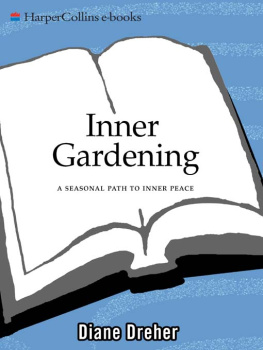I WOULD LIKE to thank Betty and Harold Johnson for planting the garden I love and my husband, Robert Numan, for helping me cultivate it on many levels. I would also like to thank the many people who have shared their insights about gardening: my mother, Mary Ann Dreher; and my friends Christiaan Lievestro and Ron and Rhonda Schlupp; along with Pat Welsh, author of Southern California Gardening ; Don Ellis, resident horticulturist at the Elizabeth Gamble Garden Center in Palo Alto, and the Master Gardeners of Santa Clara County. For insights into the relationship between outer and inner gardening, I am indebted to generations of English poets and to Stanley Stewart of the University of California, Riverside; Paul Jorgensen, Geneva Phillips, and George Guffey of UCLA; and Earl Miner of Princeton University, who introduced me to them years ago. I also benefited greatly from research in the gardens and rare book collections of the Henry E. Huntington Library in San Marino, California, and from my friendship with Janette Lewis, when we did our dissertation research there. For advice and information about medieval and Renaissance history, gardens, and spirituality, I am grateful to my friends and colleagues Ann Brady, Phyllis Brown, Rev. Brad Bunnin, Bo Caldwell, Tina Clare, Judy Dunbar, Michael Fernandez, Ron Hansen, Tom Judd, Tracey Kahan, Ed Kleinschmidt Mayes, Catherine Montfort, Elizabeth Moran, Richard Osberg, Theodore Rynes, S. J., Peggy Saad, Sunny Skys, William J. Sullivan, Tom Turley, Katherine Woodall, Cory Wade, Fred White, and my research assistant, Anna Chadney. For insights about contemplation and spiritual growth, I would especially like to thank Sister Ann Wittman, S.C.S.C., of Minocqua, Wisconsin; and William J. Rewak, S.J., director of El Retiro San Iigo, the Jesuit retreat house in Los Altos, California.
I would like to thank my agent, Sandy Dijkstra, for her encouragement and belief in this project and my editor at HarperCollins, Toni Sciarra, for her editorial artistry which helped see this book to fruition. Finally, because all of our gardens are part of the larger pattern of life on this planet, some of the royalties from this book will be used to help preserve this beautiful planet we call home.
We must cultivate our own gardens.
VOLTAIRE,
Candide (1759)
W ELCOME TO Inner Gardening, a book about growth and cultivation on many levels. Whether youre a new gardener thinking of growing vegetables in your backyard, a more experienced gardener curious about garden history, or just someone whos always loved plants, you will find in these pages practical advice and information along with something every gardener has realized: that cultivating the soil can be a powerful spiritual exercise. Working in our gardens takes us on a journey of discovery within and around us, deepening our connection to nature and ourselves.
Gardening offers a natural remedy for the escalating stress of contemporary life. Pushed along by our noisy, busy culture, too many people equate self-worth with productivity, expecting their bodies and minds to work incessantly, like machines. Yet beneath the high-tech, high-stress surface of our lives, we still move by natures rhythms, live by natures cycles. Unlike machines, each of us has our own circadian rhythms, daily energy highs and lows, as well as a very human need for balance, which we ignore at our peril.
The seasons of the year and the subtle energies of the sun and moon affect us. We are one with the universe, composed of the very elements of the stars. The blood in our veins, the planets in our solar system, and the water that sustains life on earth move in cyclical patterns. Our creative endeavors move in cycles too: artists, writers, scientists, and inventors from Coleridge to Stravinsky, Edison to Einstein, have experienced the creative process of preparation, incubation, inspiration, and verification. All of our lives have their seasons, their cycles of growth and renewalif we can only recognize them.
In the past observing these cycles was much simpler. From the Middle Ages through the Renaissance, human life was governed by the cyclical drama of nature. People lived closer to the land, beginning their days with the dawn, returning home at sunset, charting the course of their lives by the four seasons of growth, harvest, dormancy, and rebirth. We cannot return to those simpler times, but we can follow the path of poets, philosophers, saints, and sages, wise men and women throughout the ages who have found inspiration in gardening.
G ARDENING AS S PIRITUAL P RACTICE
G ARDENING HAS HELD deep significance in the spiritual traditions of East and West. Twenty-six centuries ago the Taoist sage Lao-tzu recorded the wisdom of nature in the Tao Te Ching . Meditating on the unity of creation, Taoist gardeners discovered the deeper harmonies of nature. Chinese garden design has affirmed their vision, from the early Chin dynasty in 221 B.C.E . to our own time. In Japan many Zen monks have been dedicated gardeners. With their emphasis on order, simplicity, and mindfulness, Zen gardens promote a deep meditative awareness.
In the Western tradition gardening dates back to the beginning of time, in the biblical Garden of Eden. Like Adam and Eve, early Christian hermits were gardeners. In 305 C.E ., St. Antony of Egypt founded the first In the sixth century the Rule of St. Benedict balanced gardening, prayer, and intellectual work, becoming a model for Western monasticism.
Not only saints but secular men and women have found renewal in their gardens. English monarchs who have loved gardening include Queens Eleanor of Provence, Eleanor of Castile, and Philippa of Hainaut, and King James I. The Italian poet Petrarch was an avid gardener. So was Cosimo de Medici, whose garden at Careggi became a meeting place for Renaissance humanists.
Gardens offer solace and renewal to the world-weary. In the words of the seventeenth-century English poet Andrew Marvell, All flowers and all trees do close/ To weave the garlands of repose. In their gardens the burdens of the world have fallen from the shoulders of many busy leaders, including George Washington, who grafted fruit trees at Mount Vernon, and Thomas Jefferson, who kept a journal of his garden at Monticello, recording the annual return of herbs and flowers as he struggled with political turmoil and the loss of his beloved wife. In the twentieth century, as storm clouds gathered for World War II, Winston Churchill found strength and perspective working in his garden at Chartwell, his country home in Kent.
G ARDENING AS P ERSONAL R ENEWAL
G ARDENING SLOWS US down, puts us back in touch with our own natural rhythms, teaches us patience and perseverance. It is an old Buddhist practice to plant a tree and tend it, developing a relationship of kinship, compassion, and respect that links us more deeply to the natural world and to ourselves.
Years ago I learned this lesson when my students Eric and Brendan gave me a Japanese maple for my birthday. I returned home one evening in May to find this five-foot tree in a pot by my doorstep, its delicate green leaves shimmering from a light spring rain. Through many annual cycles I cared for that tree, watered and pruned it, watched its leaves turn flaming red in autumn, then fall to the ground as the tree grew dormant. That first winter, as I found my way through a painful divorce, I moved my tree to a small apartment, where it stood outside my door. When friends came to visit they told me, Your tree is dead, so I tied a note to its branches: Dear Friends: Do not let my bare branches fool you. I am only hibernating for the winter and will bloom again in spring. That spring the tree came back to life, its tiny red buds opening into a profusion of bright green leaves. Waving gracefully in the breeze, its delicate branches seemed to greet me when I came home each day.













